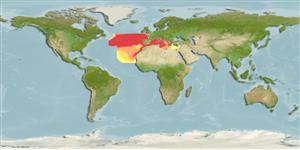Preferred temperature (Ref.
123201): 12.4 - 18.2, mean 14.3 °C (based on 18 cells).
Phylogenetic diversity index (Ref.
82804): PD
50 = 0.5156 [Uniqueness, from 0.5 = low to 2.0 = high].
Bayesian length-weight: a=0.00437 (0.00199 - 0.00957), b=3.16 (2.96 - 3.36), in cm total length, based on LWR estimates for this (Sub)family-body shape (Ref.
93245).
Trophic level (Ref.
69278): 3.1 ±0.1 se; based on size and trophs of closest relatives
Widerstandsfähigkeit (Ref.
120179): hoch, Verdopplung der Population dauert weniger als 15 Monate. (Preliminary K or Fecundity.).
Fishing Vulnerability (Ref.
59153): Low vulnerability (10 of 100).
Nutrients (Ref.
124155): Calcium = 110 [37, 276] mg/100g; Iron = 0.636 [0.278, 1.622] mg/100g; Protein = 16.6 [14.5, 18.6] %; Omega3 = 1.27 [0.55, 3.16] g/100g; Selenium = 13.8 [5.3, 41.7] μg/100g; VitaminA = 53.1 [11.1, 291.2] μg/100g; Zinc = 0.872 [0.508, 1.504] mg/100g (wet weight);
